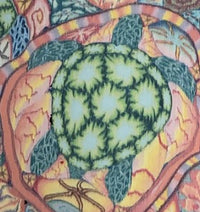Technical Information
All pottery is made in the Kapaa studio. The pieces you see on these pages are made with colored clay. The colorful designs are in the clay itself. They are glazed with a transparent glaze.
They are created by building a block of colored clay - this process is lengthy, usually taking two months depending on the size. (The final block can weigh anywhere from 20 lbs. to 120 lbs.!) Once complete, thin slices are cut from the block using fine wire. The slices are laminated to wheel thrown or slab-built work. One block will produce 4-500 pieces.
Here are a variety of colored clay pieces waiting to be assembled into a new creation. They each have a pattern in the cross-section, like individual brushstrokes waiting to be added to a canvas.
This turtle is an example of one such piece. It is the result of blending colored clay, assembling multiple pieces, and extruding it into canes before adding it to the block.
My kiln is a 24 cu. ft. updraft commercial kiln that was designed for propane. I began developing a Waste Vegetable Oil (WVO) system for the kiln in 2008. The high cost of propane in Hawaii was stressing my budget and WVO is easily available from the numerous restaurants that serve the tourist industry.
I designed and built this system from scratch. I got burner ideas from watching YouTube videos and from Jon Faulkner, an excellent potter in the Bahamas. After some experimentation, I came up with a good burner design.
Designing the fireboxes was my biggest problem because of the intense heat generated by WVO burners......10 times as much as a propane burner. Initially the fireboxes were running at about 2800°, way too hot! With no guide, trial and error was, as usual, my only teacher. I had many melted and broken bricks in the fireboxes as I figured out how to build them. After 4 rebuilds, I now use 3000° hardbrick which is holding up well.
The time and effort expended to create this system has been well worth it – I get my oil for free and save about $5,000/year in fuel costs. WVO is renewable and clean burning (no, it doesn't smell like french fries). I take some satisfaction in being "green" and artistically, I have found WVO to be a great fuel. It is very controllable and gives excellent, clean, even firings every time.
